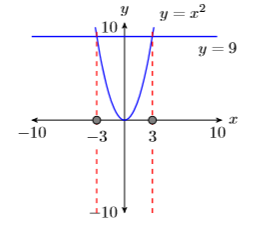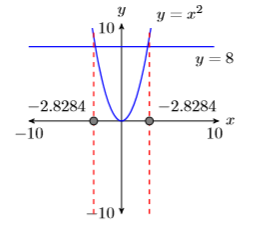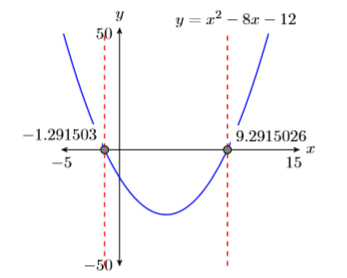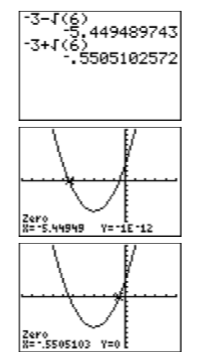8.3: Completing the Square
- Page ID
- 19900
In Introduction to Radical Notation, we showed how to solve equations such as \(x^2 = 9\) both algebraically and graphically.
\[\begin{aligned} x^{2} &=9 \\ x &=\pm 3 \end{aligned} \nonumber \]

Note that when we take the square root of both sides of this equation, there are two answers, one negative and one positive.
A perfect square is nice, but not required. Indeed, we may even have to factor out a perfect square to put our final answer in simple form.
\[\begin{aligned} x^{2} &=8 \\ x &=\pm \sqrt{8} \\ x &=\pm \sqrt{4} \sqrt{2} \\ x &=\pm 2 \sqrt{2} \end{aligned} \nonumber \]

Readers should use their calculators to check that \(-2 \sqrt{2} \approx -2.8284\) and \(2 \sqrt{2} \approx 2.8284\).
Now, let’s extend this solution technique to a broader class of equations.
Example \(\PageIndex{1}\)
Solve for \(x : (x-4)^{2}=9\)
Solution
Much like the solutions of \(x^2 = 9\) are \(x = ±3\), we use a similar approach on \((x−4)^2 = 9\) to obtain:
\[\begin{array}{rlrl}{(x-4)^{2}} & {=9} & {} & \color {Red} {\text { Original equation. }} \\ {x-4} & {=\pm 3} & {} & \color {Red} {\text { There are two square roots. }}\end{array} \nonumber \]
To complete the solution, add \(4\) to both sides of the equation.
\[x=4 \pm 3 \quad \color {Red} \text { Add } 3 \text { to both sides. } \nonumber \]
Note that this means that there are two answers, namely:
\[\begin{array}{l}{x=4-3} \\ {x=1}\end{array} \nonumber \]
or
\[\begin{array}{l}{x=4+3} \\ {x=7}\end{array} \nonumber \]
Check: Check each solution by substituting it into the original equation.
Substitute \(1\) for \(x\):
\[\begin{aligned}(x-4)^{2} &=9 \\(1-4)^{2} &=9 \\(-3)^{2} &=9 \end{aligned} \nonumber \]
Substitute \(7\) for \(x\):
\[\begin{aligned}(x-4)^{2} &=9 \\(7-4)^{2} &=9 \\(3)^{2} &=9 \end{aligned} \nonumber \]
Because the last statement in each check is a true statement, both \(x = 1\) and \(x = 7\) are valid solutions of \((x−4)^2 = 9\).
Exercise \(\PageIndex{1}\)
Solve for \(x :(x+6)^{2}=10\)
- Answer
-
\(-2\), \(-10\)
In Example \(\PageIndex{1}\), the right-hand side of the equation \((x−4)^2 = 9\) was a perfect square. However, this is not required, as the next example will show.
Example \(\PageIndex{2}\)
Solve for \(x :(x+5)^{2}=7\)
Solution
Using the same technique as in Example \(\PageIndex{1}\), we obtain:
\[\begin{array}{rlrl}{(x+5)^{2}} & {=7} & {} & \color {Red} {\text { Original equation. }} \\ {x+5} & {=\pm \sqrt{7}} & {} & \color {Red} {\text { There are two square roots. }}\end{array} \nonumber \]
To complete the solution, subtract 5 from both sides of the equation.
\[x=-5 \pm \sqrt{7} \quad \color {Red} \text { Subtract } 5 \text { from both sides.} \nonumber \]
Note that this means that there are two answers, namely:
\[x=-5-\sqrt{7} \quad \text { or } \quad x=-5+\sqrt{7} \nonumber \]
Check: Check each solution by substituting it into the original equation.
Substitute \(-5-\sqrt{7}\) for \(x\):
\[\begin{aligned}(x+5)^{2} &=7 \\((-5-\sqrt{7})+5)^{2} &=7 \\(-\sqrt{7})^{2} &=7 \end{aligned} \nonumber \]
Substitute \(-5+\sqrt{7}\) for \(x\):
\[\begin{aligned}(x+5)^{2} &=7 \\((-5+\sqrt{7})+5)^{2} &=7 \\(\sqrt{7})^{2} &=7 \end{aligned} \nonumber \]
Because the last statement in each check is a true statement, both \(x=-5-\sqrt{7}\) and \(x=-5+\sqrt{7}\) are valid solutions of \((x+5)^{2}=7\).
Exercise \(\PageIndex{2}\)
Solve for \(x :(x-4)^{2}=5\)
- Answer
-
\(4+\sqrt{5}, 4-\sqrt{5}\)
Sometimes you will have to factor out a perfect square to put your answer in simple form.
Example \(\PageIndex{3}\)
Solve for \(x :(x+4)^{2}=20\)
Solution
Using the same technique as in Example \(\PageIndex{1}\), we obtain:
\[\begin{array}{rlrl}{(x+4)^{2}} & {=20} & {} & \color {Red} {\text { Original equation. }} \\ {x+4} & {=\pm \sqrt{20}} & {} & \color {Red} {\text { There are two square roots. }} \\ {x+4} & {=\pm \sqrt{4} \sqrt{5}} & {} & \color {Red} {\text { Factor out a perfect square. }} \\ {x+4} & {=\pm 2 \sqrt{5}} & {} & \color {Red} {\text { Simplify: } \sqrt{4}=2}\end{array} \nonumber \]
To complete the solution, subtract \(4\) from both sides of the equation.
\[x=-4 \pm 2 \sqrt{5} \quad \color {Red} \text { Subtract } 4 \text { from both sides. } \nonumber \]
Note that this means that there are two answers, namely:
\[x=-4-2 \sqrt{5} \quad \text { or } \quad x=-4+2 \sqrt{5} \nonumber \]
Check: Although it is possible to check the exact answers, let’s use our calculator instead. First, store \(-4-2 \sqrt{5}\) in \(\mathbf{X}\). Next, enter the left-hand side of the equation \((x + 4)^2 = 20\) (see image on the left in Figure \(\PageIndex{3}\)). Note that (x+4)2 simplifies to 20, showing that \(-4-2 \sqrt{5}\) is a solution of \((x+4)^2 = 20\).
In similar fashion, the solution \(-4+2 \sqrt{5}\) also checks in \((x + 4)^2 = 20\) (see image on the right in Figure \(\PageIndex{3}\)).

Exercise \(\PageIndex{3}\)
Solve for \(x :(x+7)^{2}=18\)
- Answer
-
\(-7+3 \sqrt{2},-7-3 \sqrt{2}\)
Perfect Square Trinomials Revisited
Recall the squaring a binomial shortcut.
Squaring a Binomial
If \(a\) and \(b\) are any real numbers, then: \[(a±b)^2 = a^2 ±2ab + b^2 \nonumber \]That is, you square the first term, take the product of the first and second terms and double the result, then square the third term.
Reminder examples:
\[\begin{aligned}(x+3)^{2} &=x^{2}+2(x)(3)+3^{2} \\ &=x^{2}+6 x+9 \end{aligned} \nonumber \]
\[\begin{aligned}(x-8)^{2} &=x^{2}-2(x)(8)+8^{2} \\ &=x^{2}-16 x+64 \end{aligned} \nonumber \]
Because factoring is “unmultiplying,” it is a simple matter to reverse the multiplication process and factor these perfect square trinomials.
\[x^{2}+6 x+9=(x+3)^{2} \nonumber \]
\[x^{2}-16 x+64=(x-8)^{2} \nonumber \]
Note how in each case we simply take the square root of the first and last terms.
Example \(\PageIndex{4}\)
Factor each of the following trinomials:
- \(x^{2}-12 x+36\)
- \(x^{2}+10 x+25\)
- \(x^{2}-34 x+289\)
Solution
Whenever the first and last terms of a trinomial are perfect squares, we should suspect that we have a perfect square trinomial.
- The first and third terms of \(x^{2}-12 x+36\) are perfect squares. Hence, we take their square roots and try:\[x^{2}-12 x+36=(x-6)^{2} \nonumber \]Note that \(2(x)(6)=12 x\), which is the middle term on the left. The solution checks.
- The first and third terms of \(x^{2}+10 x+25\) are perfect squares. Hence, we take their square roots and try:\[x^{2}+10 x+25=(x+5)^{2} \nonumber \]Note that \(2(x)(5)=10 x\), which is the middle term on the left. The solution checks.
- The first and third terms of \(x^{2}-34 x+289\) are perfect squares. Hence, we take their square roots and try:\[x^{2}-34 x+289=(x-17)^{2} \nonumber \]Note that \(2(x)(17)=34 x\), which is the middle term on the left. The solution checks.
Exercise \(\PageIndex{4}\)
Factor: \(x^2 + 30x + 225\)
- Answer
-
\((x+15)^{2}\)
Completing the Square
In this section we start with the binomial \(x^2 +bx\) and ask the question “What constant value should we add to \(x^2 + bx\) so that the resulting trinomial is a perfect square trinomial?” The answer lies in this procedure.
Completing the square
To calculate the constant required to make \(x^2 +bx\) a perfect square trinomial:
- Take one-half of the coefficient of \(x : \dfrac{b}{2}\)
- Square the result of step one: \(\left(\dfrac{b}{2}\right)^{2}=\dfrac{b^{2}}{4}\)
- Add the result of step two to \(x^{2}+b x : x^{2}+b x+\dfrac{b^{2}}{4}\)
If you follow this process, the result will be a perfect square trinomial which will factor as follows:
\[x^{2}+b x+\dfrac{b^{2}}{4}=\left(x+\dfrac{b}{2}\right)^{2} \nonumber \]
Example \(\PageIndex{5}\)
Given \(x^2 + 12 x\), complete the square to create a perfect square trinomial.
Solution
Compare \(x^2 + 12x\) with \(x^2 + bx\) and note that \(b = 12\).
- Take one-half of \(12: 6\)
- Square the result of step one: \(6^2 = 36\)
- Add the result of step two to \(x^2 + 12x: x^2 + 12x + 36\)
Check: Note that the first and last terms of \(x^2 +12x+36\) are perfect squares. Take the square roots of the first and last terms and factor as follows:
\[x^{2}+12 x+36=(x+6)^{2} \nonumber \]
Note that \(2(x)(6) = 12x\), so the middle term checks.
Exercise \(\PageIndex{5}\)
Given \(x^2 + 16x\), complete the square to create a perfect square trinomial.
- Answer
-
\(x^{2}+16 x+64=(x+8)^{2}\)
Example \(\PageIndex{6}\)
Given \(x^2−3x\), complete the square to create a perfect square trinomial.
Solution
Compare \(x^2 −3x\) with \(x^2 + bx\) and note that \(b =−3\).
- Take one-half of \(-3 : -\dfrac{3}{2}\)
- Square the result of step one: \(\left(-\dfrac{3}{2}\right)^{2}=\dfrac{9}{4}\)
- Add the result of step two to \(x^{2}-3 x : x^{2}-3 x+\dfrac{9}{4}\)
Check: Note that the first and last terms of \(x^{2}-3 x+\dfrac {9}{4}\) are perfect squares. Take the square roots of the first and last terms and factor as follows:
\[x^{2}-3 x+\dfrac{9}{4}=\left(x-\dfrac{3}{2}\right)^{2} \nonumber \]
Note that \(2(x)\left (\dfrac {3}{2} \right)=3 x\), so the middle term checks.
Exercise \(\PageIndex{6}\)
Given \(x^2 −5x\), complete the square to create a perfect square trinomial.
- Answer
-
\(x^{2}-5 x+\dfrac {10}{4}=\left(x-\dfrac {5}{2} \right)^{2}\)
Solving Equations by Completing the Square
Consider the following nonlinear equation.
\[x^2 =2x +2 \nonumber \]
The standard approach is to make one side zero and factor.\[x^2 −2x−2=0 \nonumber \] However, one quickly realizes that there is no integer pair whose product is \(ac = −2\) and whose sum is \(b = −2\). So, what does one do in this situation? The answer is “Complete the square.”
Example \(\PageIndex{7}\)
Use completing the square to help solve \(x^2 =2x + 2\).
Solution
First, move \(2x\) to the left-hand side of the equation, keeping the constant \(2\) on the right-hand side of the equation.\[x^2 −2x =2 \nonumber \]On the left, take one-half of the coefficient of \(x: \left (\dfrac{1}{2} \right)(-2)=-1\). Square the result: \((-1)^{2}=1\). Add this result to both sides of the equation.
\[\begin{array}{l}{x^{2}-2 x+1=2+1} \\ {x^{2}-2 x+1=3}\end{array} \nonumber \]
We can now factor the left-hand side as a perfect square trinomial.
\[(x-1)^{2}=3 \nonumber \]
Now, as in Examples \(\PageIndex{1}\), \(\PageIndex{2}\), and \(\PageIndex{3}\), we can take the square root of both sides of the equation. Remember, there are two square roots.
\[x-1=\pm \sqrt{3} \nonumber \]
Finally, add \(1\) to both sides of the equation.
\[x=1 \pm \sqrt{3} \nonumber \]
Thus, the equation \(x^2 =2x+ 2\) has two answers, \(x=1-\sqrt{3}\) and \(x=1+\sqrt{3}\).
Check: Let’s use the calculator to check the solutions. First, store \(1-\sqrt{3}\) in \(\mathbf{X}\) (see the image on the left in Figure \(\PageIndex{4}\)). Then enter the left- and right-hand sides of the equation \(x^2 =2 x + 2\) and compare the results (see the image on the left in Figure \(\PageIndex{4}\)). In similar fashion, check the second answer \(1+\sqrt{3}\) (see the image on the right in Figure \(\PageIndex{4}\)).

In both cases, note that the left- and right-hand sides of \(x^2 =2x+2\) produce the same result. Hence, both \(1-\sqrt{3}\) and \(1+\sqrt{3}\) are valid solutions of \(x^2 =2x+2\).
Exercise \(\PageIndex{7}\)
Use completing the square to help solve \(x^2 =3−6x\).
- Answer
-
\(-3+2 \sqrt{3},-3-2 \sqrt{3}\)
Example \(\PageIndex{8}\)
Solve the equation \(x^2 −8x−12 = 0\), both algebraically and graphically. Compare your answer from each method.
Solution
First, move the constant \(12\) to the right-hand side of the equation.
\[\begin{aligned} x^{2}-8 x-12=0 & \quad \color {Red} \text { Original equation. } \\ x^{2}-8 x=12 & \quad \color {Red} \text { Add } 12 \text { to both sides. } \end{aligned} \nonumber \]
Take half of the coefficient of \(x :(1 / 2)(-8)=-4\). Square: \((-4)^{2}=16\). Now add \(16\) to both sides of the equation.
\[\begin{aligned} x^{2}-8 x+16 & =12+16 \quad \color {Red} \text { Add } 16 \text { to both sides. } \\ (x-4)^{2} & =28 \quad \color {Red} \text { Factor left-hand side. } \\ x-4 &=\pm \sqrt{28} \quad \color {Red} \text { There are two square roots. }\end{aligned} \nonumber \]
Note that the answer is not in simple radical form.
\[\begin{array}{rlrl}{x-4} & {=\pm \sqrt{4} \sqrt{7}} & {} & \color {Red} {\text { Factor out a perfect square. }} \\ {x-4} & {=\pm 2 \sqrt{7}} & {} & \color {Red} {\text { Simplify: } \sqrt{4}=2} \\ {x} & {=4 \pm 2 \sqrt{7}} & {} & \color {Red} {\text { Add } 4 \text { to both sides. }}\end{array} \nonumber \]
Graphical solution: Enter the equation \(y = x^2 − 8x − 12\) in \(\mathbf{Y1}\) of the Y= menu (see the first image in Figure \(\PageIndex{5}\)). After some experimentation, we settled on the WINDOW parameters shown in the middle image of Figure \(\PageIndex{5}\). Once you’ve entered these WINDOW parameters, push the GRAPH button to produce the rightmost image in Figure \(\PageIndex{5}\).

We’re looking for solutions of \(x^2 −8x−12 = 0\), so we need to locate where the graph of \(y = x^2 −8x−12\) intercepts the \(x\)-axis. That is, we need to find the zeros of \(y = x^2 −8x−12\). Select 2:zero from the CALC menu, move the cursor slightly to the left of the first \(x\)-intercept and press ENTER in response to “Left bound.” Move the cursor slightly to the right of the first \(x\)-intercept and press ENTER in response to “Right bound.” Leave the cursor where it sits and press ENTER in response to “Guess.” The calculator responds by finding the \(x\)-coordinate of the \(x\)-intercept, as shown in the first image in Figure \(\PageIndex{6}\).
Repeat the process to find the second \(x\)-intercept of \(y = x^2−8x−12\) shown in the second image in Figure \(\PageIndex{6}\).

Reporting the solution on your homework: Duplicate the image in your calculator’s viewing window on your homework page. Use a ruler to draw all lines, but freehand any curves.
- Label the horizontal and vertical axes with \(x\) and \(y\), respectively (see Figure \(\PageIndex{7}\)).
- Place your WINDOW parameters at the end of each axis (see Figure \(\PageIndex{7}\)).
- Label the graph with its equation (see Figure \(\PageIndex{7}\)).
- Drop dashed vertical lines through each \(x\)-intercept. Shade and label the \(x\)-values of the points where the dashed vertical line crosses the \(x\)-axis. These are the solutions of the equation \(x^2−8x−12 = 0\) (see Figure \(\PageIndex{7}\)).

Thus, the graphing calculator reports that the solutions of \(x^2 −8x−12 = 0\) are \(x \approx-1.291503\) and \(x \approx 9.2915026\).
Comparing exact and calculator approximations: How well do the graphing calculator solutions compare with the exact solutions, \(x=4-2 \sqrt{7}\) and \(x=4+2 \sqrt{7}\)? After entering each in the calculator (see Figure \(\PageIndex{8}\)), the comparison is excellent!

Exercise \(\PageIndex{8}\)
Solve the equation \(x^2 +6x + 3 = 0\) both algebraically and graphically, then compare your answers.
- Answer
-
\(-3-\sqrt{6},-3+\sqrt{6}\)



